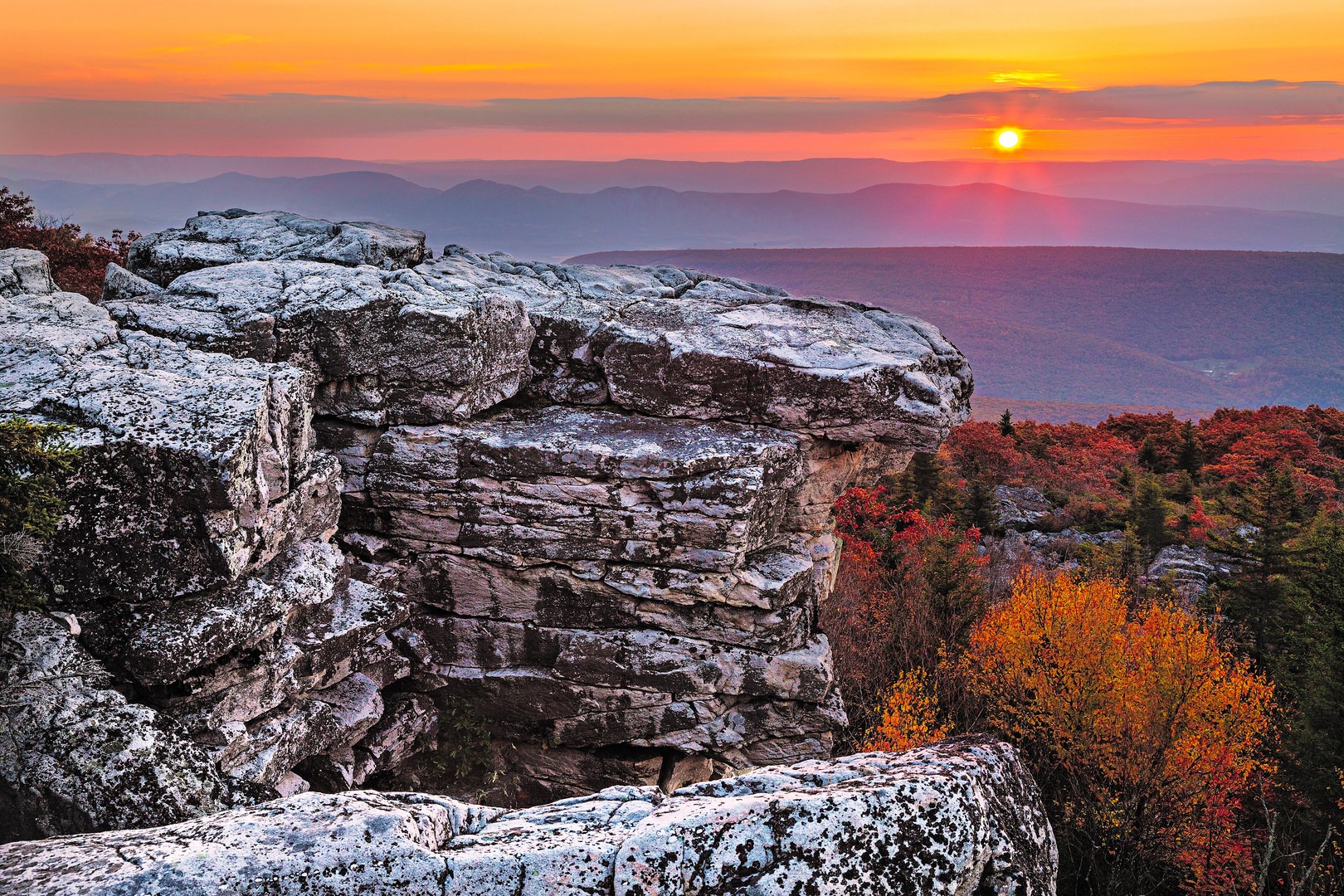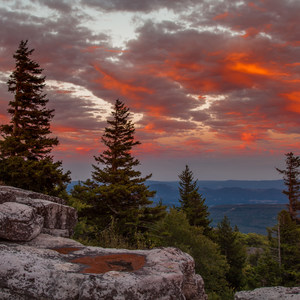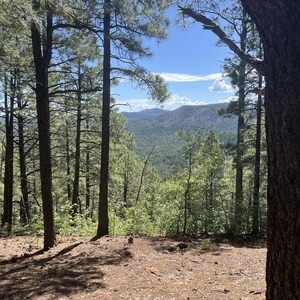You are here
Perched on the precipice of the Eastern Continental Divide and high on the edge of the Allegheny Plateau sits the Bear Rocks Preserve. It is only 477 acres, and it is owned by The Nature Conservancy, but it is a place of such extraordinary beauty that many feel it represents the most iconic images of the Dolly Sods area and surrounding wildernesses. Bear Rocks is located along the principal access road to the Dolly Sods region, FS 75. As such, Bear Rocks often provides the most lasting impression for many visitors as they crest the Eastern Continental Divide on their way to the wilderness. Bear Rocks may easily be the most photographed area in West Virginia due to easy access and breathtaking splendor.
The wind-swept landscape with unpredictable and often severe weather offers views in all directions. East of the cliffs at Bear Rocks lies the Potomac River Valley with its deep river chasm followed by the long north-south ridgelines dividing all the Potomac’s major tributaries. To the southeast, North Fork Mountain is the first of these ridgelines, and it is topped with a long line of stark gray-white cliffs. Great hiking exists there along the North Fork Mountain Trail, which many consider some of the best in the Mid-Atlantic for the nearly continuous cliff top views. Facing south and west is the undulating heath bogs of the Allegheny Plateau sprinkled with the numerous wind-scoured “flag” trees and sculptured rocks, products of the persistent winds and blowing snow and ice. Again, fantastic hiking exists here, including parts of the Dolly Sods and Roaring Plains wildernesses. The Allegheny Plateau continues to the north, but it contains more private inholdings, and its beauty is disturbed by the Mount Storm coal fired power plant. New wind turbines also mar the view, but in their own green way, so they may be considered less disturbing.
Unlike the adjacent wilderness, there are no formal trails in the preserve, but hiking is allowed along the faint trails through the heath bogs and along the tops of the cliffs. It is easy to get confused and follow a different trail back, but you’re not going to get lost because the parking areas is normally always in sight. While exploring the preserve, watch the kids along the cliff tops and fractured rocks that inspire kids (and adults alike) to try their hands at rock climbing.
Since access to the Bear Rocks Preserve and surrounding areas is easy to all but the lowest slung cars, this is a crowded area. The gravel FS 75 road arrives from the east providing access from the greater metropolitan areas of Pittsburgh, Washington and Baltimore. The gravel FS 19 road provides access from the south and west for central Virginia and West Virginia. FS 75 and 19 form the eastern and southern boundaries for the Dolly Sods Wilderness. To the west, the high Canaan Valley, with its ski areas, wildlife reserves, and state parks, forms the western boundary of Dolly Sods Wilderness. The parking by Bear Rocks is jointly shared by the preserve and the trailhead for the Bear Rocks Trail that provides the northernmost access to the major trails of the Dolly Sods Wilderness. On weekends parking spots can be hard to find.
There are extensive backpacking and day hiking opportunities in the surrounding area. Nearby car camping is limited to the small Red Creek Campground about 2.4 miles south of Bear Rocks on FS 75. Part of the reason for the Red Creek Campground filling up is its small size, and part is the popularity of the region. But Red Creek Campground also serves as the base of operations for a major Mid-Atlantic bird census operation. Many of the bird census takers “live” at the campground during the census taking, so in mid-summer to early fall, even with an early Friday morning arrival, the campground is full. Red Creek Campground is a great access point to the central area of the Dolly Sods Wilderness via the Blackbird Knob Trail, and it provides access to the numerous falls and cascades along Red Creek.
Ecologic diversity, caused by the unique geologic conditions of the area, contributes to the regions exceptionality. Though the glaciers never made it to the region, the high plateau and cold climate during the last ice age “trapped” islands of ecosystems much more common to Canada than to more southern regions. The two ecosystems are intermixed in this area, creating the unique juxtaposition of northern and southern flora and fauna. Mankind has also had a major role in shaping Dolly Sods, and mostly a negative role at that. One of the first written records about the area, written by the Lord Fairfax survey in 1736, makes mention of the vast, nearly impenetrable red spruce forests that covered the high plateau. The Dahle family settled the area in mid-1800s and used the few original open sods in the area for grazing sheep. The Americanization of Dahle is the source of the name for the area, Dolly Sods. In the late 19th and early 20th century, the timber extraction industry swept the area clear of the vast old-growth forests. Sparks from timber trains caused many fires that burned the exposed and dried-out humus topsoil for months, often “sterilizing” the area for decades. Instead of magnificent spruce-pine forest, sweeping bogs and heaths are prevalent throughout the area. Though created by humans, the open bogs remain beautiful results of nature’s regeneration process. The final assault to the region when the Army used it as a training ground to prepare troops to free Europe from Nazi Germany. There are caution signs at all the affected trailheads warning of the danger of unexploded ordnance. The trails were extensively swept in the mid-1990s and are considered safe by the Forest Service, but cross-country travel does pose an increased risk and should be avoided.
In the 1970s, The Nature Conservancy bought 15,000 acres of the mineral rights in the area and transferred them to Monongahela National Forest. In 1975, Dolly Sods Wilderness was created. Again, The Nature Conservancy helped with the late 1990s expansion of Dolly Sods Wilderness with the purchase and transfer to the Forest Service of the northern portions of the wilderness. They only kept the small area of Bear Rocks Preserve, and they generously allow public access.
Dolly Sods Wilderness covers 17,371 acres with 47 miles of challenging wilderness trails that can provide a lifetime of hiking destinations ranging from waterfalls, to deep forests and eye-popping clifftop views. Roaring Plains Wilderness was established in 2009, and it has a limited set of official trails. There is no direct car access to the trailheads, so you must hike through the Flat Rocks section of the MNF from trailheads along FS19 to gain access. The trails are rougher, but significantly less crowded than Dolly Sods. They aren’t quite as spectacular as Dolly Sods, but the remoteness more than makes up for it. There are some “unofficial” hard to follow trails that require expert navigation and backcountry skills, but provide dramatic views from remote locations.
The best map of the area is Purple Lizard’s “Dolly Sods and Seneca Rocks”. It is weather resistant, accurate, and covers much of the best areas in the northeastern sections of the Monongahela National Forest, including Dolly Sods (accessible via FS19 and 75) and Roaring Plains (accessible via FS 19) wildernesses, and the sprawling Seneca Rocks-Spruce Knob National Recreation Area (which contains the spectacular North Fork Mountain Trail mentioned earlier). Some other great sources of information for the Dolly Sods and surrounding areas are Bruce Sundquist’s guide book, “Monongahela National Forest Hiking Guide,” now in its 8th edition, and the hard-to-find maps produced by the “Bushwhackers” who hiked all the trails and obscure routes in the Dolly Sods, Flat Rocks, and Roaring plains area in the early 2000 time frame. These maps were made by a small team of dedicated local hikers who hiked with a GPS and made routes with all the cascades and viewpoints they could record. Unfortunately, these highly informative maps can only be found in local stores in Canaan Valley and the towns of Davis and Thomas, West Virginia. They are a great source of the best hiking destinations in the area, but they are not official or officially field reviewed, so use with common sense.
All the trails in this area are only maintained to wilderness standards. Strong navigation and hiking skills are required along with common sense. The weather can switch quickly and be severe, even in summer. The creeks do not have bridges and are dangerous to cross when the water is high. Dolly Sods receives an average of 150 inches of snow in the winter, closing most road access. In spring through late fall, FS 75 and FS19 are the major access routes to the south and eastern boundaries of Dolly Sods Wilderness. FS 19 also provides access to Roaring Plains via the few trailheads in the Flat Rock section of Monongahela National Forest. In good weather, these areas are busy. But in winter, with the gating of Forest Service roads, access to the eastern side is difficult except with long slogs along dirt roads that are often covered in deep snow. Winter exploration along the western ridge top boundary of the wilderness offers freezing wind-swept temperatures, but for the prepared, a fantastic trip of ice encased tress, deep snow, and eye-popping views. For the really hardy souls who are well trained and prepared winter adventures, venturing into the interior of the wilderness offers isolation, views, ice-covered river banks, and waterfalls along Red Creek.











Comments
Sign In and share them.